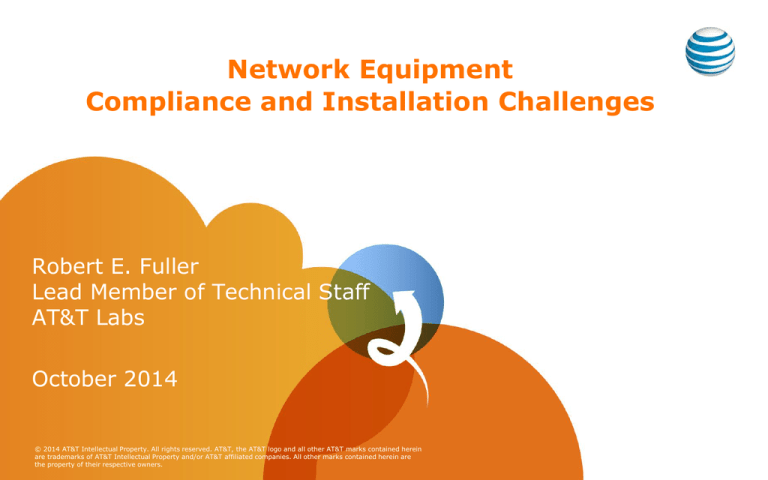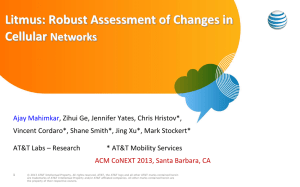
Network Equipment
Compliance and Installation Challenges
Robert E. Fuller
Lead Member of Technical Staff
AT&T Labs
October 2014
© 2014 AT&T Intellectual Property. All rights reserved. AT&T, the AT&T logo and all other AT&T marks contained herein
are trademarks of AT&T Intellectual Property and/or AT&T affiliated companies. All other marks contained herein are
the property of their respective owners.
Topics
• Lead Free Solder/RoHS 6/6 Compliance
• Thermal Management, Airflow Requirements,
Impacts, and Solutions
• Cable Management
• Power Distribution
• Equipment Size and Weight
2
© 2014 AT&T Intellectual Property. All rights reserved. AT&T, the AT&T logo and all other AT&T marks contained herein
are trademarks of AT&T Intellectual Property and/or AT&T affiliated companies. All other marks contained herein are
the property of their respective owners.
Lead Free Solder/RoHS 6/6
Compliance Challenges
• Industry concerns about solder joint reliability in lead
free products remain
• EU Exemption expires July 2016
• Vendors need to provide clear understanding of
• what products are currently compliant, what will be
discontinued, and what will be re-designed to be compliant
• The impacts on sparing and maintenance procedures
3
© 2014 AT&T Intellectual Property. All rights reserved. AT&T, the AT&T logo and all other AT&T marks contained herein
are trademarks of AT&T Intellectual Property and/or AT&T affiliated companies. All other marks contained herein are
the property of their respective owners.
Topics
• Lead Free Solder/RoHS 6/6 Compliance
• Thermal Management, Airflow Requirements,
Impacts, and Solutions
• Cable Management
• Power Distribution
• Equipment Size and Weight
4
© 2014 AT&T Intellectual Property. All rights reserved. AT&T, the AT&T logo and all other AT&T marks contained herein
are trademarks of AT&T Intellectual Property and/or AT&T affiliated companies. All other marks contained herein are
the property of their respective owners.
Thermal Management, Air Flow
Requirements, Impact, and Solutions
• Heat and Power Estimation - Manufacturer’s Specified Heat Values vs.
Actual Measured Values.
• Cooling the Chassis – Difficult to air cool equipment beyond 20 – 25
KW heat loads within acoustic noise limits. Trade off: air flow vs.
electronics.
• Removing the Heat – How to cool and re-circulate the hot exhaust air
from air cooled equipment. Older building are not designed for high
heat loads.
• Improving PUE (Power Usage Effectiveness)
• AT&T Standards
5
© 2014 AT&T Intellectual Property. All rights reserved. AT&T, the AT&T logo and all other AT&T marks contained herein
are trademarks of AT&T Intellectual Property and/or AT&T affiliated companies. All other marks contained herein are
the property of their respective owners.
Heat and Power Estimation
Challenges of Heat and Power estimation
• Manufacturer’s Specified Heat Values vs. Actual Measured Values
Results reporting Requirements
• AT&T ESP (Engineering and Space Planning) Form – Requires separate
and distinct values for Nominal and Maximum
• Part specific values (e.g., chassis, cards, etc.)
• ATIS (Alliance for Telecommunications Industry Solutions)– Charts heat
and power at 0, 25%, 50%, 75%, 100% (max) equipment utilization
• System total values (measured, calculated or estimated)
6
© 2014 AT&T Intellectual Property. All rights reserved. AT&T, the AT&T logo and all other AT&T marks contained herein
are trademarks of AT&T Intellectual Property and/or AT&T affiliated companies. All other marks contained herein are
the property of their respective owners.
Cooling The Chassis
• Air Cooling: Difficult to air cool
equipment beyond 20 – 25 KW heat
loads within acoustic noise limits, power,
air impedance (rear door, grill, etc.
issues), high speed exhaust. Chassis
design trade off: air flow vs. electronics.
• Liquid cooling (submersive, direct
contact)
• Hybrid: Air cooling with liquid cooling to
hottest components
7
© 2014 AT&T Intellectual Property. All rights reserved. AT&T, the AT&T logo and all other AT&T marks contained herein
are trademarks of AT&T Intellectual Property and/or AT&T affiliated companies. All other marks contained herein are
the property of their respective owners.
Removing the Heat:
Efficiency Improvements
Increased hot/cold aisle temperature gradient leads to greater
cooling efficiency. This can be achieved by:
• Consistent front to rear airflow
• In cabinet hot/cold isolation
• Hot or cold aisle containment
8
© 2014 AT&T Intellectual Property. All rights reserved. AT&T, the AT&T logo and all other AT&T marks contained herein
are trademarks of AT&T Intellectual Property and/or AT&T affiliated companies. All other marks contained herein are
the property of their respective owners.
Consistent Airflow: Typical Solution for
Side Airflow Chassis
Airflow Redirector - Plenum
9
© 2014 AT&T Intellectual Property. All rights reserved. AT&T, the AT&T logo and all other AT&T marks contained herein
are trademarks of AT&T Intellectual Property and/or AT&T affiliated companies. All other marks contained herein are
the property of their respective owners.
Consistent Airflow: Typical Solution for
Fuse Panels
Heat Ramp
Front View
10
© 2014 AT&T Intellectual Property. All rights reserved. AT&T, the AT&T logo and all other AT&T marks contained herein
are trademarks of AT&T Intellectual Property and/or AT&T affiliated companies. All other marks contained herein are
the property of their respective owners.
Rear View
Cabinet Modifications:
Hot/Cold Aisle Isolation
Filler panels, top air blocking panel,
silicon pass-through inserts, foam inserts
11
© 2014 AT&T Intellectual Property. All rights reserved. AT&T, the AT&T logo and all other AT&T marks contained herein
are trademarks of AT&T Intellectual Property and/or AT&T affiliated companies. All other marks contained herein are
the property of their respective owners.
Cabinet Modifications: Top Panel Isolation
Top panel brush and cover plate kit
12
© 2014 AT&T Intellectual Property. All rights reserved. AT&T, the AT&T logo and all other AT&T marks contained herein
are trademarks of AT&T Intellectual Property and/or AT&T affiliated companies. All other marks contained herein are
the property of their respective owners.
Hot/Cold Aisle Containment
• “Bathtub” Solutions
• Can be hot or cold aisle isolation depending upon the
particular cooling infrastructure
• 3 sided containment
• 5 sided containment
13
© 2014 AT&T Intellectual Property. All rights reserved. AT&T, the AT&T logo and all other AT&T marks contained herein
are trademarks of AT&T Intellectual Property and/or AT&T affiliated companies. All other marks contained herein are
the property of their respective owners.
Hot/Cold Aisle Containment
All distributed cooling systems require containment to effectively
separate the supply and return air. Containment increase the
temperature gradient (delta T) between these air masses by reducing
mixing of supply and return air.
14
© 2014 AT&T Intellectual Property. All rights reserved. AT&T, the AT&T logo and all other AT&T marks contained herein
are trademarks of AT&T Intellectual Property and/or AT&T affiliated companies. All other marks contained herein are
the property of their respective owners.
Hot/Cold Aisle Containment
Three sided containment will provide 70% effectiveness in separating
supply and return air.
15
© 2014 AT&T Intellectual Property. All rights reserved. AT&T, the AT&T logo and all other AT&T marks contained herein
are trademarks of AT&T Intellectual Property and/or AT&T affiliated companies. All other marks contained herein are
the property of their respective owners.
Hot/Cold Aisle Containment
Five sided containment will provide 96% effectiveness in separating
supply and return air.
It is not necessary to provide difficult top containment to get
significant results from adding containment to equipment areas.
16
© 2014 AT&T Intellectual Property. All rights reserved. AT&T, the AT&T logo and all other AT&T marks contained herein
are trademarks of AT&T Intellectual Property and/or AT&T affiliated companies. All other marks contained herein are
the property of their respective owners.
Aisle Containment Installation
Challenges
Aisle Containment in Partial Cabinet Line-Ups
17
© 2014 AT&T Intellectual Property. All rights reserved. AT&T, the AT&T logo and all other AT&T marks contained herein
are trademarks of AT&T Intellectual Property and/or AT&T affiliated companies. All other marks contained herein are
the property of their respective owners.
Aisle Containment Installation
Challenges
Containment Doors and Panels
18
© 2014 AT&T Intellectual Property. All rights reserved. AT&T, the AT&T logo and all other AT&T marks contained herein
are trademarks of AT&T Intellectual Property and/or AT&T affiliated companies. All other marks contained herein are
the property of their respective owners.
Distributed Refrigerant Cooling (DRC)
DRC Solutions
• In row cooling - requires hot/cold aisle separation
• Back of cabinet cooling
• DRC direct to equipment
19
© 2014 AT&T Intellectual Property. All rights reserved. AT&T, the AT&T logo and all other AT&T marks contained herein
are trademarks of AT&T Intellectual Property and/or AT&T affiliated companies. All other marks contained herein are
the property of their respective owners.
Distributed Cooling Installation
Challenges
Equipment may not have the necessary airflow to support
passive rear door coolers nor air flow re-directors to push air
down and to the sides to in-row cooler intakes. Small, high
speed exhaust outlets compound the problems.
Possible solutions include active doors (not currently
commercially available), placing in-row coolers in adjacent aisles
directly behind the equipment, or making aisle space into a giant
in-row cooler plenum.
20
© 2014 AT&T Intellectual Property. All rights reserved. AT&T, the AT&T logo and all other AT&T marks contained herein
are trademarks of AT&T Intellectual Property and/or AT&T affiliated companies. All other marks contained herein are
the property of their respective owners.
Economization
• Economization is using the natural exterior temperature as a cooling
source and is becoming a requirement for all cooling systems.
• The key to effective “Economization” is to increase supply air
temperatures modestly and drive return air temperatures as high as
possible to allow for the greatest window of “economization hours” in
any climate.
• Economization can be done with heat exchangers to address air
quality concerns or may be done with direct air exchange.
• The use of “Economization” and “Containment” will generate an
average 40% improvement of PUE in a mild climate. Cool climates
will see a greater savings while warm climate will see less but still
significant savings.
21
© 2014 AT&T Intellectual Property. All rights reserved. AT&T, the AT&T logo and all other AT&T marks contained herein
are trademarks of AT&T Intellectual Property and/or AT&T affiliated companies. All other marks contained herein are
the property of their respective owners.
AT&T Thermal Standard
• AT&T’s Thermal Standard is ATT-812-000-705. The standard
details traditional cooling systems, raised floor systems, DRC
systems, multiple containment strategies, economization and
thermal management space solutions.
• A support document numbered ATT-812-000-705 ANNEX has
been created to discuss and illustrate manufacture specific
solutions and products in support of ATT-812-000-705.
• AT&T’s Thermal Standards are proprietary documents and
require approval for access.
22
© 2014 AT&T Intellectual Property. All rights reserved. AT&T, the AT&T logo and all other AT&T marks contained herein
are trademarks of AT&T Intellectual Property and/or AT&T affiliated companies. All other marks contained herein are
the property of their respective owners.
Topics
• Lead Free Solder/RoHS 6/6 Compliance
• Thermal Management, Airflow Requirements,
Impacts, and Solutions
• Cable Management
• Power Distribution
• Equipment Size and Weight
23
© 2014 AT&T Intellectual Property. All rights reserved. AT&T, the AT&T logo and all other AT&T marks contained herein
are trademarks of AT&T Intellectual Property and/or AT&T affiliated companies. All other marks contained herein are
the property of their respective owners.
Cable Management Challenges
Office cable racking and chassis cable management are
size constrained
•
Typical cable types are cat 5/6 cable and 1.6/2.0 mm breakouts/jumpers
•
Fiber cable management may not accommodate fiber drip loops
•
Chassis may support up to 600 cat 5/6 or 1000 individual fiber ports (2000
strands)
•
High density MPO connectors used to increase port density require the use of
breakout cables to the optical distribution frame
•
Rack mount equipment may not have any vertical cable management
Large quantities of cat 5/6 require custom cable management
Large quantities of fiber are difficult to house in vertical FPS
•
Distribution cable with 900 micron fiber used on front is upjacketed to 2.0 mm
•
Breakout cable uses 1.6mm cordage end-to-end
•
24
Smaller within bay, but more costly and takes more rack space
© 2014 AT&T Intellectual Property. All rights reserved. AT&T, the AT&T logo and all other AT&T marks contained herein
are trademarks of AT&T Intellectual Property and/or AT&T affiliated companies. All other marks contained herein are
the property of their respective owners.
Cat 5/6 UTP
Less congestion on card
faces, in equipment and
rack cable managers,
and in overhead ladder
racking leading to lower
installation costs and
improved ease of
maintenance
“Thin” versions of Cat 6 cable are approximately 20%
smaller, 10% lighter, and more flexible than standard
Cat 6 cable
25
© 2014 AT&T Intellectual Property. All rights reserved. AT&T, the AT&T logo and all other AT&T marks contained herein
are trademarks of AT&T Intellectual Property and/or AT&T affiliated companies. All other marks contained herein are
the property of their respective owners.
Fiber Initiatives – 1.2 mm Jumpers
(Simplex and Duplex)
Fiber Cordage Used to Manufacture Jumpers
3.0mm, 2.0mm, 1.6mm, 1.2mm
3.0mm, 2.0mm, 1.2mm
simplex BIF cordage
duplex BIF cordage
26
© 2014 AT&T Intellectual Property. All rights reserved. AT&T, the AT&T logo and all other AT&T marks contained herein
are trademarks of AT&T Intellectual Property and/or AT&T affiliated companies. All other marks contained herein are
the property of their respective owners.
Fiber Initiatives – 1.2 mm Jumpers
(Simplex and Duplex)
72 fibers
1.6mm
72 fibers
1.2 mm
1.2 mm jumpers are 44%
smaller than 1.6mm jumpers =
1.5 times more fibers in the
same space
1.2 mm jumpers are 64%
smaller than 2.0 mm jumpers =
2.8 times more fibers in the
same space
Both 1.2mm simplex (shown) and duplex jumpers successfully
trialed in AT&T network and now in production use
27
© 2014 AT&T Intellectual Property. All rights reserved. AT&T, the AT&T logo and all other AT&T marks contained herein
are trademarks of AT&T Intellectual Property and/or AT&T affiliated companies. All other marks contained herein are
the property of their respective owners.
Fiber Initiatives – 1.2 mm Breakout Cable
Currently 1.6mm breakout cable is used when 900
micron distribution cable up-jacketed to 2.0 mm is
too large
1.2mm 12 fiber breakout cable
Penalty: 40% larger than 900 micron
for 72 count cable
1.6mm 12 fiber breakout cable
Penalty: 80% larger than 900 micron
for 72 count cable
1.2 mm is 42% smaller, 30% lighter than 1.6mm
and allows 2.8X more 1.2 mm fibers in the same
space than 2.0 mm up-jacketed fiber
28
© 2014 AT&T Intellectual Property. All rights reserved. AT&T, the AT&T logo and all other AT&T marks contained herein
are trademarks of AT&T Intellectual Property and/or AT&T affiliated companies. All other marks contained herein are
the property of their respective owners.
Fiber Initiatives – 96 Strand MicroCables
Eight subgroups each with twelve 250 micron fibers
29
© 2014 AT&T Intellectual Property. All rights reserved. AT&T, the AT&T logo and all other AT&T marks contained herein
are trademarks of AT&T Intellectual Property and/or AT&T affiliated companies. All other marks contained herein are
the property of their respective owners.
Fiber Initiatives – Backbone Micro Cables
Prototype 72f Micro Cable – 250 micron
fiber: 7.2 mm Diameter
12f 1.2mm Breakout Cable: 6.4 mm Diameter
12f 1.6mm Breakout Cable: 7.6 mm Diameter
72f Distribution Cable – 900 micron fiber
18.5mm dia.: 6.6x cross-sectional area of microcable
72f Breakout Cable – 1.2mm fiber
22.0mm dia.: 9x cross-sectional area of microcable
72f Breakout Cable – 1.6mm fiber
24.9mm dia.: 12x cross-sectional area of
microcable
30
© 2014 AT&T Intellectual Property. All rights reserved. AT&T, the AT&T logo and all other AT&T marks contained herein
are trademarks of AT&T Intellectual Property and/or AT&T affiliated companies. All other marks contained herein are
the property of their respective owners.
Fiber Initiatives – MPO Connectors
• Used to increase density and versatility of physical ports
compared to SC and LC connectors
• High density low speed (1 GE) ports where card faceplate
does not have sufficient room for LC connectors
• 10 x 10 GE CFP in 100 GE “electrical” port adds versatility and
reduces costs for composite 100 GE signal compared to full
100GE
• 2 x 4 x 10GE in 100 GE “electrical” port adds versatility and
reduces costs for composite 40 GE signal compared to full
40GE
31
© 2014 AT&T Intellectual Property. All rights reserved. AT&T, the AT&T logo and all other AT&T marks contained herein
are trademarks of AT&T Intellectual Property and/or AT&T affiliated companies. All other marks contained herein are
the property of their respective owners.
Fiber Challenges – MPO Pin Outs
32
© 2014 AT&T Intellectual Property. All rights reserved. AT&T, the AT&T logo and all other AT&T marks contained herein
are trademarks of AT&T Intellectual Property and/or AT&T affiliated companies. All other marks contained herein are
the property of their respective owners.
Fiber Challenges – MPO Pin Outs
33
© 2014 AT&T Intellectual Property. All rights reserved. AT&T, the AT&T logo and all other AT&T marks contained herein
are trademarks of AT&T Intellectual Property and/or AT&T affiliated companies. All other marks contained herein are
the property of their respective owners.
Fiber Challenges – MPO Pin Outs
Receive
Transmit
1
10
1
10
OR
34
Back to back
hybrid cable
Receive
1
10
Transmit
10
1
10 x 10GE
© 2014 AT&T Intellectual Property. All rights reserved. AT&T, the AT&T logo and all other AT&T marks contained herein
are trademarks of AT&T Intellectual Property and/or AT&T affiliated companies. All other marks contained herein are
the property of their respective owners.
Back to back
roll over cable
Back to back
cross over
cable
Fiber Challenges – MPO Pin Outs
1
10
1
Transmit
10
Receive
OR
10
1
1
Receive
Transmit
10 x 10GE
35
10
© 2014 AT&T Intellectual Property. All rights reserved. AT&T, the AT&T logo and all other AT&T marks contained herein
are trademarks of AT&T Intellectual Property and/or AT&T affiliated companies. All other marks contained herein are
the property of their respective owners.
Fiber Challenges – MPO Pin Outs
Receive
1
4
1
4
Receive
Transmit
1
4
1
4
Transmit
2 x 4 x 10GE
1
4
4
4 x 10GE
36
1
1
Legs are a
straight and
roll over cable
variant
© 2014 AT&T Intellectual Property. All rights reserved. AT&T, the AT&T logo and all other AT&T marks contained herein
are trademarks of AT&T Intellectual Property and/or AT&T affiliated companies. All other marks contained herein are
the property of their respective owners.
4
4
4 x 10GE
1
Fiber Challenges – MPO Pin Outs
Receive
1
12
Transmit
1
12
OR
Receive
1
12
Transmit
12
1
8 x 12 x 1GE (e.g. 96 port 1 GE card)
37
© 2014 AT&T Intellectual Property. All rights reserved. AT&T, the AT&T logo and all other AT&T marks contained herein
are trademarks of AT&T Intellectual Property and/or AT&T affiliated companies. All other marks contained herein are
the property of their respective owners.
Fiber Challenges – MPO Pin Outs
OR
Receive
1
3
2
4
5
12
Transmit
1
2
3
4
5
12
OR
38
???
© 2014 AT&T Intellectual Property. All rights reserved. AT&T, the AT&T logo and all other AT&T marks contained herein
are trademarks of AT&T Intellectual Property and/or AT&T affiliated companies. All other marks contained herein are
the property of their respective owners.
MPO Cable and Connector Challenges
Cable and breakout must be compatible with chassis cable
management, FPS, and rack installations
Optics “Pin outs” vary by manufacturer
Connector numbering varies by manufacturer
KEY
39
MPO13
MPO14
MPO15
MPO16
MPO17
MPO18
MPO19
MPO20
MPO21
MPO22
MPO23
MPO24
MP01
MPO2
MPO3
MPO4
MPO5
MPO6
MPO7
MPO8
MPO9
MPO10
MPO11
MPO12
LOWER ROW
UPPER ROW
B1
B2
B3
B4
B5
B6
B7
B8
B9
B11
© 2014 AT&T Intellectual Property. All rights reserved. AT&T, the AT&T logo and all other AT&T marks contained herein
are trademarks of AT&T Intellectual Property and/or AT&T affiliated companies. All other marks contained herein are
the property of their respective owners.
A4
A5
Fiber Challenges – MPO Breakout
Cables to LGX
• Pin outs can vary for the same size and speed connector and
will vary for same size connector for different speeds.
• MPO – MPO cable pin outs are specific to the optics at each
end and can be plugged in with the ends backwards.
• Need different breakout cable pin outs (MPO – SC/LC) based
on connector pin out and size.
• Fiber strand colors must correspond to the T/R pairs at the
breakout end. This means different cable builds, not just
different labeling. (slide?)
40
© 2014 AT&T Intellectual Property. All rights reserved. AT&T, the AT&T logo and all other AT&T marks contained herein
are trademarks of AT&T Intellectual Property and/or AT&T affiliated companies. All other marks contained herein are
the property of their respective owners.
Fiber Initiatives – MPO Breakout
Cables
900 micron
breakout to LGX
41
1.6 mm breakout to
equipment front panel
© 2014 AT&T Intellectual Property. All rights reserved. AT&T, the AT&T logo and all other AT&T marks contained herein
are trademarks of AT&T Intellectual Property and/or AT&T affiliated companies. All other marks contained herein are
the property of their respective owners.
Fiber Initiatives – MPO to MPO Cables
Pin out varies by both
application and optics
24 fiber MPO-MPO
42
•
Straight
•
Cross-over
•
Rolled
•
Hybrid
•
And more
?
And how do you know
© 2014 AT&T Intellectual Property. All rights reserved. AT&T, the AT&T logo and all other AT&T marks contained herein
are trademarks of AT&T Intellectual Property and/or AT&T affiliated companies. All other marks contained herein are
the property of their respective owners.
Topics
• Lead Free Solder/RoHS 6/6 Compliance
• Thermal Management, Airflow Requirements,
Impacts, and Solutions
• Cable Management
• Power Distribution
• Equipment Size and Weight
43
© 2014 AT&T Intellectual Property. All rights reserved. AT&T, the AT&T logo and all other AT&T marks contained herein
are trademarks of AT&T Intellectual Property and/or AT&T affiliated companies. All other marks contained herein are
the property of their respective owners.
Power Cable Management Challenges
• Chassis may require up to 36 DC power cable pairs or 24
single phase 220 VAC cords
• Typically no power cable management is provided
• AC cords typically do not “lock” into the chassis receptacles
• N + 1 power supply redundancy schemes are not practical to
implement in the field (would require N + 1 BDFB loads)
• A + B power feed redundancy to each power module results in
double the number of feeds and little reliability improvement
44
© 2014 AT&T Intellectual Property. All rights reserved. AT&T, the AT&T logo and all other AT&T marks contained herein
are trademarks of AT&T Intellectual Property and/or AT&T affiliated companies. All other marks contained herein are
the property of their respective owners.
Solution: Distributed Architecture (DA)
Power Plant
• A DA Plant is located near the equipment it serves,
saving copper
• Scalable from 850A – 3800A depending upon
required battery reserve
• In some cases, requires a new battery technology
Sodium Metal Halide, aka “Sodium Salt”
• At room temperature, battery is table salt, nickel,
iron, and alumina
45
© 2014 AT&T Intellectual Property. All rights reserved. AT&T, the AT&T logo and all other AT&T marks contained herein
are trademarks of AT&T Intellectual Property and/or AT&T affiliated companies. All other marks contained herein are
the property of their respective owners.
DC Power Plant Architecture Features
Centralized Architecture
• Single large DC power plant for
office
• Large DC batteries in the power
room (basement)
• Long DC primary power circuits
• Requires BDFBs
• Requires short secondary
distribution
• Requires bay FAPs for most NEs
• Voltage drop from BDFB to NE is
typically limited to 0.5V loop
• Short AC feeds to rectifiers
• Heavy lead acid battery technology
Distributed Architecture (DA)
• Multiple small DC power plants for areas
• Small DC batteries in the equipment area
• “Primary” distribution in the traditional sense is
eliminated
• BDFBs are eliminated
• “Secondary” distribution technically becomes
primary
• Bay FAPs can be eliminated for most NEs
• Voltage drop from PBD to NE = 1.75V loop,
effectively eliminating all transition devices; i.e.,
cable size is #2 AWG for most 125A circuits
• Longer AC feeds to rectifiers – more PDSCs
• Lighter alternate battery technology
DA Plants = less copper
46
© 2014 AT&T Intellectual Property. All rights reserved. AT&T, the AT&T logo and all other AT&T marks contained herein
are trademarks of AT&T Intellectual Property and/or AT&T affiliated companies. All other marks contained herein are
the property of their respective owners.
Solution: Mini “BDFB”
Six 600A loads, 10 fuse positions/load
Equipment Cost Savings of ~50%
47
© 2014 AT&T Intellectual Property. All rights reserved. AT&T, the AT&T logo and all other AT&T marks contained herein
are trademarks of AT&T Intellectual Property and/or AT&T affiliated companies. All other marks contained herein are
the property of their respective owners.
Solution: Bridging Clips
48
•
Bridging Clips are used on Demarcation Fuse
Panels to provide 2 or more outputs for a single
input.
•
Bridging clips are used with high current (125A)
BDFBs where individual power inputs are fused at
>50A and the total load of multiple fuse outputs
will not exceed 125A.
•
Special cases include planning for growth and
redundant chassis power supply inputs.
•
This saves secondary power cable installation
costs, BDFB fuse positions, cable rack and cable
hole congestion = $$$.
© 2014 AT&T Intellectual Property. All rights reserved. AT&T, the AT&T logo and all other AT&T marks contained herein
are trademarks of AT&T Intellectual Property and/or AT&T affiliated companies. All other marks contained herein are
the property of their respective owners.
2:1 Bridging Clips
49
© 2014 AT&T Intellectual Property. All rights reserved. AT&T, the AT&T logo and all other AT&T marks contained herein
are trademarks of AT&T Intellectual Property and/or AT&T affiliated companies. All other marks contained herein are
the property of their respective owners.
2:1 Bridging Clip Example
50
© 2014 AT&T Intellectual Property. All rights reserved. AT&T, the AT&T logo and all other AT&T marks contained herein
are trademarks of AT&T Intellectual Property and/or AT&T affiliated companies. All other marks contained herein are
the property of their respective owners.
4:1 Bridging Clip Example
16 60A redundant feeds 4 125A feeds
51
© 2014 AT&T Intellectual Property. All rights reserved. AT&T, the AT&T logo and all other AT&T marks contained herein
are trademarks of AT&T Intellectual Property and/or AT&T affiliated companies. All other marks contained herein are
the property of their respective owners.
Topics
• Lead Free Solder/RoHS 6/6 Compliance
• Thermal Management, Airflow Requirements,
Impacts, and Solutions
• Cable Management
• Power Distribution
• Equipment Size and Weight
52
© 2014 AT&T Intellectual Property. All rights reserved. AT&T, the AT&T logo and all other AT&T marks contained herein
are trademarks of AT&T Intellectual Property and/or AT&T affiliated companies. All other marks contained herein are
the property of their respective owners.
Equipment Size and Weight Challenges
• Rack mount units may exceed the 44 ru standard 7’
rack/cabinet VPO and/or may be very deep
• Both standalone and rack mount chassis may exceed 1500#
when fully populated.
• “Green” shipping means everything in one >1500# crate –
how do you move it from loading dock to installation site
especially if FRUs must be removed first
• Challenge to deliver to and transport equipment within the
office (too tall, too heavy, cannot be tilted)
• Challenge to install in cabinet due to size and weight
• Cabinet/rack must support 1500# or more
53
© 2014 AT&T Intellectual Property. All rights reserved. AT&T, the AT&T logo and all other AT&T marks contained herein
are trademarks of AT&T Intellectual Property and/or AT&T affiliated companies. All other marks contained herein are
the property of their respective owners.
Cabinet and Rack Design Challenges
• Must incorporate hot/cold aisle separation while allowing front
to rear cable access and provide vertical cable management
• Mounting rail design must support plenums needed to correct
side air flow.
• Heat ramps to correct top to bottom airflow (e.g. fuse panels)
must allow for various equipment offsets, depths, etc.
• Cabinet must support over 1500# while maintaining zone 4
seismic compliance
• Cabinets, if required, must accommodate equipment over 44
ru high
• Cabinet design must allow for in-cabinet cable management
54
© 2014 AT&T Intellectual Property. All rights reserved. AT&T, the AT&T logo and all other AT&T marks contained herein
are trademarks of AT&T Intellectual Property and/or AT&T affiliated companies. All other marks contained herein are
the property of their respective owners.
Cabinet Modifications
Reduced Top and Bottom Cowlings
55
© 2014 AT&T Intellectual Property. All rights reserved. AT&T, the AT&T logo and all other AT&T marks contained herein
are trademarks of AT&T Intellectual Property and/or AT&T affiliated companies. All other marks contained herein are
the property of their respective owners.
Cabinet Modifications
Pocket Rails, Base Chassis Support
56
© 2014 AT&T Intellectual Property. All rights reserved. AT&T, the AT&T logo and all other AT&T marks contained herein
are trademarks of AT&T Intellectual Property and/or AT&T affiliated companies. All other marks contained herein are
the property of their respective owners.
Questions?
AT&T & Our Vendors
Partnering for Success
57
© 2014 AT&T Intellectual Property. All rights reserved. AT&T, the AT&T logo and all other AT&T marks contained herein
are trademarks of AT&T Intellectual Property and/or AT&T affiliated companies. All other marks contained herein are
the property of their respective owners.





